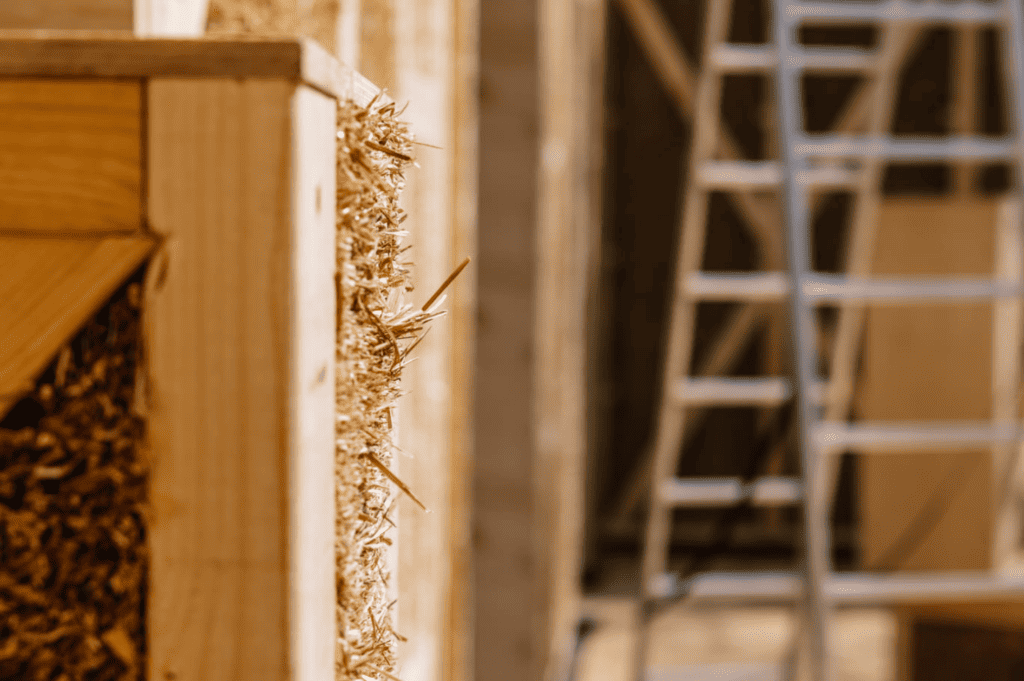In an era where sustainability is paramount, innovative construction methods are emerging to address environmental concerns while meeting the demands of modern architecture.
One such method is structural straw bale construction, particularly through systems like EcoCocon. Combining ancient wisdom with modern technology, this approach offers a sustainable, energy-efficient, and cost-effective alternative to conventional building techniques. In this article, Tina Humphreys, part of our Architectural Team delves into the concept of straw bale construction, its advantages, and misconceptions.
The Essence of Straw Bale Construction:
Straw bale construction dates back centuries, rooted in agricultural societies where straw was a readily available byproduct. Rather than using traditional materials like concrete or steel, straw bale construction utilises densely packed straw bales as load-bearing elements. These bales are typically encased in plaster or other natural materials to form walls, offering excellent insulation properties.
Advantages of Straw Bale Construction:
- Environmental Sustainability: Utilising straw, a renewable agricultural resource, reduces the reliance on non-renewable materials. This minimizes the carbon footprint associated with construction and helps mitigate climate change. Made up with 98% natural renewable materials, it can sequester tons of CO2 for each project.
- Energy Efficiency: Straw bale walls provide superior insulation, effectively regulating indoor temperatures and reducing the need for heating and cooling. This leads to lower energy consumption and decreased utility bills over the building’s lifespan.
- Cost-Effectiveness: In many regions, straw bales are abundant and inexpensive compared to conventional building materials. Additionally, the simplicity of construction can lower labour costs, making it an affordable option for both residential and commercial projects.
- Health and Comfort: The natural properties of straw contribute to healthier indoor environments by allowing moisture regulation and preventing the buildup of mould and toxins. Additionally, the thick walls offer excellent sound insulation, enhancing occupants’ comfort and well-being.
- Enhanced Performance: Panels are designed for optimal insulation performance, surpassing conventional building materials. The panels’ air tightness and thermal mass contribute to superior energy efficiency, creating comfortable indoor environments year-round.
- Design Flexibility: Despite misconceptions, straw bale construction offers versatile design possibilities. With proper planning and engineering, it can create aesthetically pleasing structures ranging from traditional to contemporary styles.
- Precision Engineering: The panels are precision-engineered to ensure consistency and structural integrity. This guarantees that each panel meets stringent quality standards, simplifying the construction process and reducing on-site errors.
- Time and Labor Efficiency: Utilizing prefabricated panels such as EcoCocon can significantly accelerate the construction timeline. Builders can assemble structures quickly and efficiently, saving time and labour costs.
At the beginning of February this year there was an article on the BBC website about a learning centre and community hub building in West Yorkshire. Originally built in the 1950s the team at Todmorden Learning Centre plan to clad the building in straw panels to better insulate it. With a discussion on whether more British homes should be built using straw, the article talks about a new factory opening up for the launch of these new straw panel systems. It also discusses the fact that there are limitations, such as that the walls need to be 400-500mm thick. However, with the changes to the Building Regulations for newly built homes and the increasing levels of insulation needed, thicker wall construction will become more common.
An advisor also comments in the article regarding insurers and how they will have high premiums for homes that are built with less common materials.
“Insurers will want to be confident about how resilient these building materials are and how they might react in a fire, storm, flood, or to extreme temperatures, damp and subsidence,” says Louise Clark, general insurance policy adviser at the Association of British Insurers.
In the quest for sustainable construction solutions, straw bale construction stands out as a time-tested method with modern relevance. As we confront the challenges of climate change and resource depletion, embracing sustainable technologies is not just a choice but a necessity for building a resilient and harmonious future.
Whilst recognising that ultimately it is up to the client what they want to do and what their budget allows for, at Planning & Design we can advise them on the different levels of sustainability available, provide information on the latest research and the full knowledge of the options, the current and emerging renewable technologies and how much these cost to incorporate into their projects.
Please feel free to contact us if you require any additional information or to discuss any specific projects on 01332 347371 or email enquiries@planningdesign.co.uk
Main Image: EcoCocon



